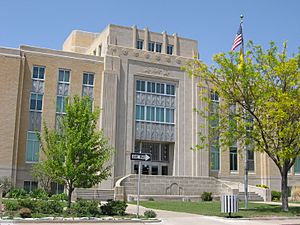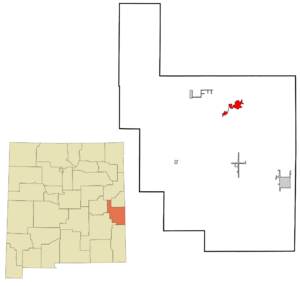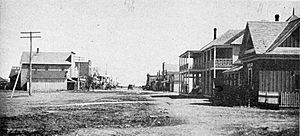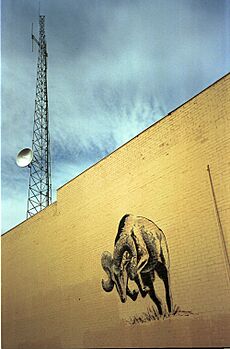Portales, New Mexico facts for kids
Quick facts for kids
Portales, New Mexico
|
||
|---|---|---|

Roosevelt County Courthouse in Portales
|
||
|
||

Location of Portales, New Mexico
|
||
| Country | ||
| State | ||
| County | Roosevelt | |
| Area | ||
| • Total | 8.01 sq mi (20.74 km2) | |
| • Land | 8.01 sq mi (20.74 km2) | |
| • Water | 0.00 sq mi (0.00 km2) | |
| Elevation | 4,013 ft (1,223 m) | |
| Population
(2020)
|
||
| • Total | 12,137 | |
| • Density | 1,515.61/sq mi (585.20/km2) | |
| Time zone | UTC−07:00 (Mountain (MST)) | |
| • Summer (DST) | UTC−06:00 (MDT) | |
| ZIP Codes |
88123, 88130
|
|
| Area code(s) | 575 | |
| FIPS code | 35-59260 | |
| GNIS feature ID | 2411469 | |
| Website | portalesnm.org | |
Portales is a city in New Mexico, United States. It is the main city of Roosevelt County. In 2020, about 12,137 people lived there.
Portales is close to Clovis and Cannon Air Force Base. This air base is very important for the local economy.
Eastern New Mexico University (ENMU) is located in Portales. It started in 1934 and is now the third-largest university in New Mexico.
The area is famous for growing Valencia peanuts. It is also the top producer of certified organic peanut butter in the United States. Portales has many dairies that produce and export a lot of milk products every year.
Contents
History of Portales
Portales was settled in the late 1800s. Cattle herders found a water source coming from a rocky area that looked like a Spanish porch. They named this spot "Portales," which means "porches" in Spanish.
A few settlers started ranching nearby. The Pecos Valley and Northeastern Railroad arrived in 1899. The city of Portales was officially created in 1909. Washington E. Lindsey became the first mayor. He later became the governor of New Mexico.
The town grew steadily in the early 1900s. New ways of watering crops helped farming grow. This was possible because of the Ogallala Aquifer, a large underground water supply.
Eastern New Mexico University was founded in 1934. It began as a college to train teachers. Later, it became a four-year university. During the Great Depression, several important buildings were built. These include the ENMU Administration Building, the Post Office, and the Roosevelt County Courthouse. All three are now listed as historic places.
In 2023, a big project started to bring drinking water from the Ute Reservoir. This pipeline will provide water to Portales, Clovis, and Cannon Air Force Base by 2030.
Geography and Climate
Portales is located in the eastern part of New Mexico. The city covers about 6.8 square miles (17.6 square kilometers). The area around Portales is mostly farmland and open ranges.
City Layout
The downtown area of Portales has a traditional town square. This design is similar to old Spanish towns. In the center of the square is the Roosevelt County Courthouse. It was built in the 1930s and has unique old designs. The post office, also from the 1930s, is next to it.
Shops and businesses surround the Courthouse Square. The Yam Theater, a historic movie theater downtown, has been updated recently. Eastern New Mexico University has a large campus. Many students live in the homes around the university. The university is a major center for arts and culture in the city.
Weather in Portales
Portales has a semiarid climate. This means it gets hot summers with most of its rain from thunderstorms. Winters are usually dry, with cold mornings but mild and sunny afternoons.
| Climate data for Portales, New Mexico (1981–2010) | |||||||||||||
|---|---|---|---|---|---|---|---|---|---|---|---|---|---|
| Month | Jan | Feb | Mar | Apr | May | Jun | Jul | Aug | Sep | Oct | Nov | Dec | Year |
| Mean daily maximum °F (°C) | 54.3 (12.4) |
59.3 (15.2) |
67.0 (19.4) |
75.5 (24.2) |
83.9 (28.8) |
91.0 (32.8) |
91.8 (33.2) |
89.7 (32.1) |
84.4 (29.1) |
74.9 (23.8) |
62.9 (17.2) |
53.4 (11.9) |
74.0 (23.3) |
| Mean daily minimum °F (°C) | 23.9 (−4.5) |
27.3 (−2.6) |
33.3 (0.7) |
41.2 (5.1) |
51.3 (10.7) |
60.5 (15.8) |
64.3 (17.9) |
63.3 (17.4) |
55.6 (13.1) |
44.1 (6.7) |
32.0 (0.0) |
24.1 (−4.4) |
43.4 (6.3) |
| Average precipitation inches (mm) | 0.60 (15) |
0.40 (10) |
0.80 (20) |
0.74 (19) |
1.54 (39) |
2.53 (64) |
2.52 (64) |
3.25 (83) |
1.91 (49) |
1.67 (42) |
0.68 (17) |
0.70 (18) |
17.32 (440) |
| Average snowfall inches (cm) | 1.5 (3.8) |
1.2 (3.0) |
0.6 (1.5) |
0.1 (0.25) |
0.0 (0.0) |
0.0 (0.0) |
0.0 (0.0) |
0.0 (0.0) |
0.0 (0.0) |
0.1 (0.25) |
0.4 (1.0) |
2.4 (6.1) |
6.3 (16) |
| Source: NOAA | |||||||||||||
Population and People
| Historical population | |||
|---|---|---|---|
| Census | Pop. | %± | |
| 1910 | 1,292 | — | |
| 1920 | 1,154 | −10.7% | |
| 1930 | 2,519 | 118.3% | |
| 1940 | 5,104 | 102.6% | |
| 1950 | 8,112 | 58.9% | |
| 1960 | 9,695 | 19.5% | |
| 1970 | 10,554 | 8.9% | |
| 1980 | 9,940 | −5.8% | |
| 1990 | 10,690 | 7.5% | |
| 2000 | 11,131 | 4.1% | |
| 2010 | 12,280 | 10.3% | |
| 2020 | 12,137 | −1.2% | |
| U.S. Decennial Census | |||
In 2000, about 11,131 people lived in Portales. By 2007, the number of people living in and around Portales grew to almost 17,000. Eastern New Mexico University had over 4,300 students and 700 staff in 2008.
In 2000, most people in Portales were White (68.80%). About 23.39% were from other races, and 3.35% were from two or more races. About 38.13% of the population was Hispanic or Latino.
The average age in Portales in 2000 was 27 years old. About 26.3% of the people were under 18. About 20.1% were between 18 and 24, many of whom were likely students.
Economy
Portales is a major exporter of certified organic peanut products in the U.S. It is also a big processor and distributor of sweet Valencia peanuts.
The city's economy is also linked to Cannon Air Force Base. This base is about 13 miles (21 km) north of Portales. The base has a housing area in Portales with 150 homes for military families.
Transportation and Roads
Major roads in Portales include US 70, NM 88, and NM 206.
The BNSF railway provides freight services to the city.
The Portales Municipal Airport is located southwest of the city. It is used for general aviation, which means it handles private and charter flights.
Famous People from Portales
- John Burroughs: He was the Democratic governor of New Mexico from 1959 to 1961.
- Ronny Cox: An actor, singer, and songwriter. He was in the movie Deliverance and the TV show Apple's Way.
- Ed Foreman: He represented both Texas and New Mexico in the United States House of Representatives. He is also a motivational speaker.
- Darynda Jones: A writer known for her paranormal, mystery, and young-adult books.
- Wayne Mass: An American football player.
- Cody Ross: A professional baseball player.
- Christopher Stasheff: A fantasy author.
- Ned Sublette: A singer and expert on Cuban culture.
- Jack Williamson: A well-known science-fiction author.
See also
 In Spanish: Portales (Nuevo México) para niños
In Spanish: Portales (Nuevo México) para niños







